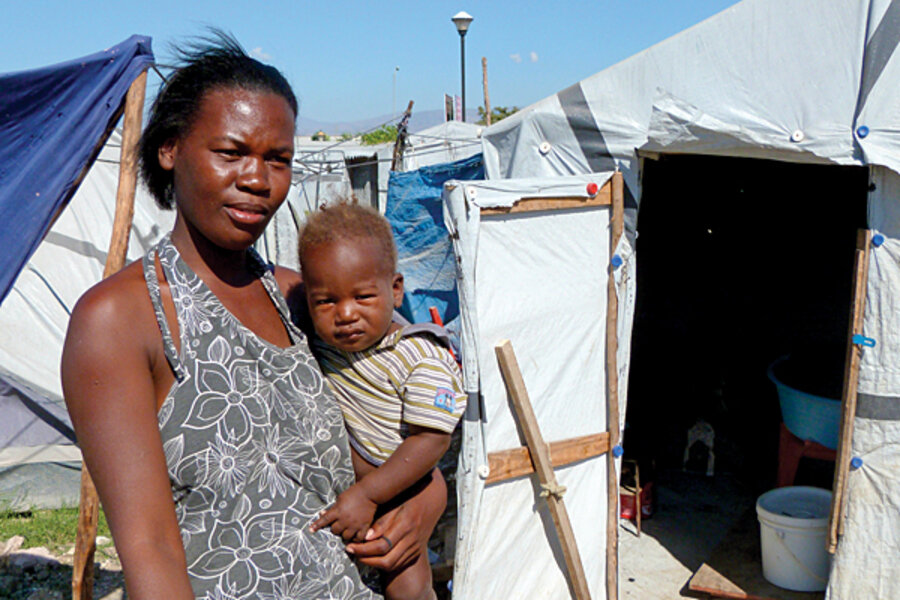In Haiti, cautious hope around effort to find families new homes
Loading...
| Port-au-Prince, Haiti
For nearly two years, some 2,000 families lived crammed together in a makeshift camp called Maïs Gaté on the outskirts of Port-au-Prince. Set up spontaneously in the wake of Haiti’s 2010 earthquake, it was an unforgiving stretch of land, barren, rendering the insides of tents unbearable through much of the year.
Now, only burned logs, some toothbrushes, and broken toys bear testament to two years of uncertainty and desperation for thousands of displaced Haitians. On Jan. 12, the two-year anniversary of the earthquake, almost everyone had gone: Residents moved out in December as part of a resettlement program called 16/6, which aims ultimately to relocate displaced people living in six refugee camps back to their 16 original neighborhoods.
The plan, announced in July by President Michel Martelly, offers cash to families to rent a home while the 16 badly damaged boroughs of the city where they were living are refurbished. It is run through four United Nations agencies in partnership with the national government, as well as local city councils. Four camps have been cleared and the remaining two are set to be emptied soon.
To some observers, that is testament to the benefits of a plan that lets the homeless move into proper shelter. But others say it is not a sustainable solution, as refurbishing of houses has barely started and rebuilding may not start for months.
Amid a painfully slow reconstruction process hampered by politics and the chaotic flow of donor funds, the government-appointed director of the program, Clément Belizaire, is optimistic about the program’s impact. “It is the model we plan to extend to other camps,” he says enthusiastically.
But concerns remain. First, 16/6 only targets a fraction of people still displaced in Haiti: 30,000 are targeted, out of the 515,000 living in more than 700 camps. Second, its funding is shaky: with costs estimated at $78 million, only $30 million is currently secured by the Haiti Reconstruction Fund because of bureaucratic snags.
This financial uncertainty is further amplified by the fact that the Interim Haiti Recovery Commission, the body established to coordinate relief efforts and the allocation of resources, ended its 18-month mandate last October and a new mandate has not been extended, amid split opinions about its actual accomplishments. And many worry that the philosophical underpinnings of the plan – including getting residents back to their places of origin – is only a goal on paper, as Haitians are likely to scatter to wherever they can find an affordable place, most likely in a poorer area.
“What saved Haitians, even in the worst camp conditions, was the community spirit whereby everybody helped his neighbor,” says Nicole Phillips, staff attorney at the Institute for Justice and Democracy in Haiti, whose lawyers monitor the respect of human rights and the accountability of international actors in Haiti. “When you break up these communities and their ties, surviving becomes more difficult.”
Humanitarian groups partnering in the project consider it a step in the right direction. “Giving cash to people to move, when integrated within a reconstruction and recovery plan, can be a very effective method,” says Emmett Fitzgerald, program manager for 16/6 for the International Office on Migration. But extending the plan is possible only if rebuilding proceeds at the same pace, as there would never be enough housing for the entire population living in camps.
Residents of camps also support it. In a shady corner of the Maïs Gaté camp, a young man named Jackie, a young father of three, eagerly takes down his family tent at the end of December. “I can’t wait to leave the camp. It took me a long time to find a house,” he says, not interrupting his work. He will pay the equivalent of $500 for a year’s rent, a sum the program underwrote.
The money is given to residents only when they find a house, to prevent people from taking the money and living under tarps elsewhere. Those who negotiate a lower rent can keep the difference.
The Red Cross is responsible for the relocation of people at Maïs Gaté. “This program allows a follow-up: Those who are relocated will later receive an additional $500 to start an activity, and some professional training,” says Jean-Baptiste Pericles, communication officer of the Haitian Red Cross.
“Clearly, this is better than using violence to force evictions. But many points are still unanswered,” says Ms. Phillips. “This cash-giving model is not sustainable for the poor. What will happen in a year from now? Thousands of people who left the camps today will be homeless again. And they won’t be allowed to return to camps.”
And not everyone has been able to move. Almost alone, Claircil Luxarmor stands amid the litter of destroyed tents at the Maïs Gaté camp, holding her baby. She lost her husband in the earthquake. The “K059” painted on her shelter indicates that she can benefit from the relocation program if she finds a new place. “We have not been able to find another place. I cannot work nor look for a house as I need to take care of my children,” she says. “We feel condemned to stay here.”





